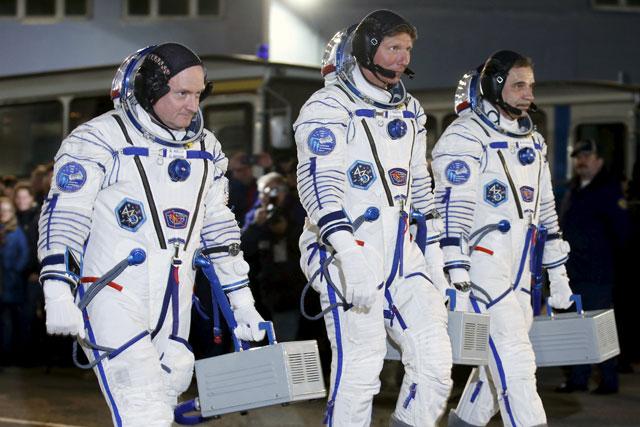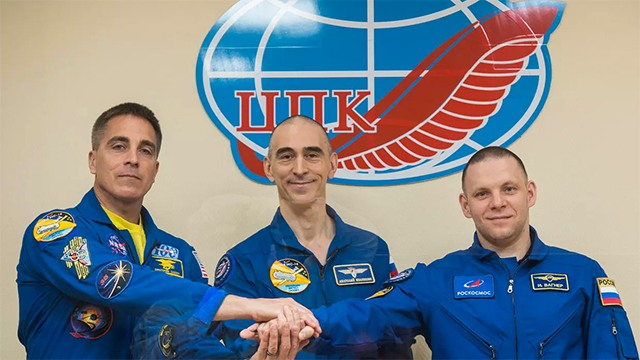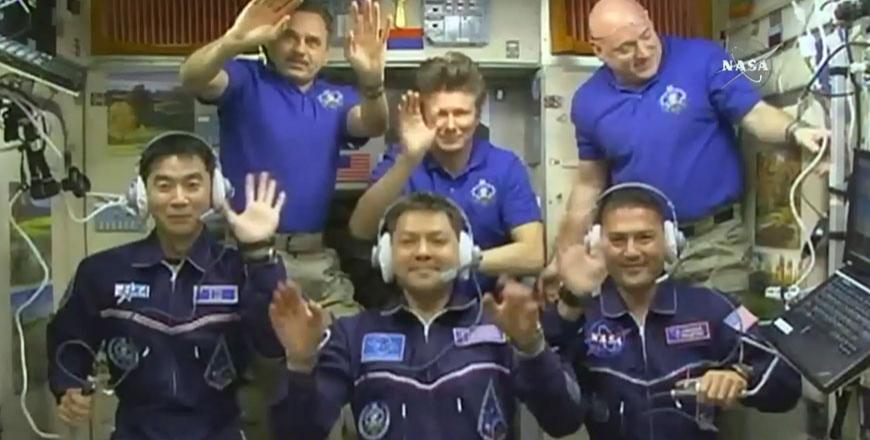You are here
Astronauts board space station for one-year mission
By AP - Mar 28,2015 - Last updated at Mar 28,2015

BAIKONUR, Kazakhstan — Two Russians and an American floated into the International Space Station (ISS) on Saturday, beginning what is to be a year away from Earth for two of them.
Mikhail Kornienko and Scott Kelly are to spend 342 days aboard the orbiting laboratory, about twice as long as a standard mission on the station. Russia's Gennady Padalka is beginning a six-month stay.
The three astronauts entered the station about eight hours after launching from Russia's manned space facility in Kazakhstan. They were embraced by American Terry Virts and Russia's Anton Shkaplerov who along with Italian Samantha Cristoforetti have been aboard since late November.
The trip is NASA's first attempt at a one-year spaceflight; four Russians have spent a year or more in space, all on the Soviet-built Mir space station.
The stay is aimed at measuring the effects of a prolonged period of weightlessness on the human body, a step towards possible missions to Mars or beyond.
Kelly's identical twin Mark, a retired astronaut, agreed to take part in many of the same medical experiments as his orbiting sibling to help scientists see how a body in space compares with its genetic double on Earth. They are 51.
Kelly and Kornienko, 54, will remain on board until next March. During that time, they will undergo extensive medical experiments, and prepare the station for the anticipated 2017 arrival of new US commercial crew capsules. That means a series of spacewalks for Kelly, which will be his first.
The two men also will oversee the comings and goings of numerous cargo ships, as well as other Russian-launched space crews and an expected September visit from singer Sarah Brightman on a "space tourist" trip.
Doctors are eager to learn what happens to Kelly and Kornienko once they surpass the usual six-month stay for space station residents.
Bones and muscles weaken in weightlessness, as does the immune system. Body fluids also shift into the head when gravity is absent, putting pressure on the brain and the eyes, impairing vision for some astronauts in space.
The yearlong stint will allow doctors to assess whether such conditions are aggravated by a long spell in space or whether they reach a point of stasis or even taper off.
As space officials look to longer missions, the International Space Station's future appears ensured until at least 2024.
Last year, as tensions between Russia and the United States grew amid the dispute over Russia's role in Ukraine, Deputy Prime Minister Dmitry Rogozin had said Moscow aimed to exit the project in 2020.
But Russian space agency director, Igor Komarov, told a post-launch news conference in Baikonur that his agency and NASA have agreed to continue using the station until 2024.
In addition, "Roscosmos and NASA will work on a programme for a future orbiting station. We will think about discuss joint projects," he said. Just last month, Roscosmos said it foresaw creating a Russian station for use after 2024.
NASA has never flown anyone longer than seven consecutive months. The Russians hold the world record of 14 months in space, set by Valery Polyakov aboard the former Mir space station in 1994-95. Several other Russians spent between 8 and 12 months at Mir. All but one of those long timers are still alive.
A year in space will carry not only physical challenges, but emotional ones as well.
Related Articles
ALMATY,Kazakhstan — A three-man crew docked successfully at the International Space Station on Thursday, leaving behind a planet overw
By Anastasia ClarkAgence France-PresseMOSCOW — A Russian actress and director arrived at the International Space Station (ISS) on Tuesday to
MOSCOW — Astronauts from Russia, Japan and the United States Thursday docked successfully with the International Space Station after a two-m













